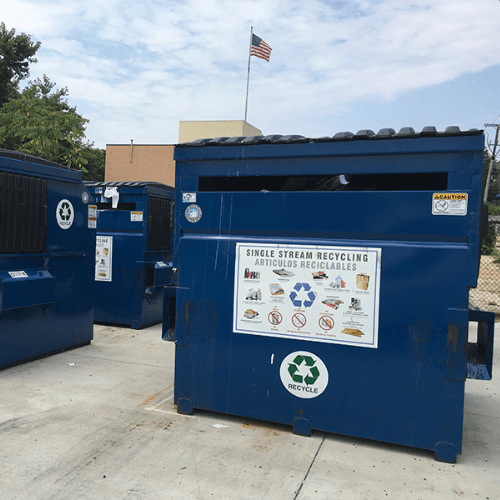Have you ever considered how to recycle your pillow? Most of us don’t think about this when it comes to our bedding. To help the environment, you can take a few simple steps.
The idea of recycling may seem overwhelming, but it’s actually quite simple. Taking the time to properly dispose of items like pillows can help keep them out of landfills and reduce waste.
Read on to learn how to recycle your pillow responsibly.
1. Identifying Whether Your Pillow Is Recyclable

Re-purposing an old pillow can be a breath of fresh air!
It’s time to reset the clock on your tired cushion and make the most out of what you already have. But before you begin, there’s one crucial step: identifying whether your pillow is recyclable.
First, check the label.
Most pillows are made from synthetic materials like polyester and nylon, which aren’t as easily recyclable as natural fibers such as cotton or wool.
If you have a synthetic pillow, see if there’s any nearby textile recycling centers that accept them – it’s worth checking!
Next, assess for dirt and other contaminants.
Pillows should be clean and dry before they’re recycled to avoid any additional contamination.
Many reuse centers won’t take dirty pillows, so make sure yours has been washed and dried thoroughly.
With these steps taken care of, you’ll be ready to tackle the recycling process with confidence.
2. Preparing Your Pillow For Recycling
Before you can recycle your pillow, it needs to be prepared. Start by removing any tags or labels that came with the item.
These items can be recycled in the same way as paper, so separate them from the pillow itself.
Next, take apart the pillow and separate out all of its components: stuffing, fabric covers, pillowcases, etc.
If there are any metal parts like zippers or buttons, they should be removed and placed in a metal recycling bin.
Finally, check if any part of the pillow is made of foam rubber or memory foam.
If so, this material will need to be recycled separately.
TIP: Check with your local recycling center for more information about how to recycle these types of materials. With all of these steps completed, you are now ready to take your pillow to a recycling center for proper disposal.
3. Finding A Recycling Center For Your Pillow

Before you can start recycling your pillow, you must locate a center that accepts it.
Do some research online or in your area to find out which centers will take textile items like pillows.
Here are some steps to help you:
- Contact your local recycling centers and see if they accept pillow donations or recycle textiles.
- Check with charities and donation centers in your community to see if they accept used pillows for redistribution or recycling.
- Ask friends and family if they know of any places that might be able to help you with pillow recycling.
- Look into large-scale textile recyclers that may pick up from your location or have drop-off sites near you.
- Look for specific manufacturers who offer pillow recycling programs and/or locations where you can drop off the pillow for remanufacturing.
Once you’ve determined the best place to take your pillow, make sure it’s clean and ready for recycling with no lingering debris before bringing it in—it’s important to follow the center’s instructions closely so the item is recycled properly.
Then, transport it safely to the center and drop it off as needed!
Transporting The Pillow Parts To The Recycling Center
Transport the pillow parts to the recycling center.
Get a box and package each part separately. Label each piece with its material type, so it can be sorted properly.
Once you have everything ready, take it to the nearest recycling center. Some centers accept donations for free, but others need payment.
Find out which applies to your local center before transporting the pillow parts.
When you arrive at the center, hand in your items and get a receipt for proof of donation or payment.
This is important; even if you’re donating for free, you’ll need a receipt for your records.
It’s also helpful when completing the recycling process later on.
Completing The Recycling Process
Transporting the pillow was the first step. Now, it’s time to finish up the recycling process.
Begin by sorting out any foam pieces from the fabric parts of your pillow.
Separate them into two piles; one for foam and another for fabric.
Make sure you’ve got everything sorted correctly before moving on.
Now, take both piles to your local recycling center.
Many centers accept these materials, so check with them to see if they do. Follow their instructions when disposing of your items.
The job is done!
With a bit of effort and some knowledge, you’ve successfully recycled your pillow.

Frequently Asked Questions
What Types Of Pillows Can Be Recycled?
Since pillows are made of different materials, they must be recycled accordingly. It is important to know what type of pillow you have so you can properly recycle it.
Down and synthetic pillows can be recycled at many locations that accept textiles for reuse or donation. You can find a list of these locations online or by calling a local recycling center.
Additionally, some specialty retailers may offer an “end-of-life” program where they will take back your used pillow and recycle it for you.
Synthetic foam pillows are usually not accepted by textile recyclers, but some companies may still reuse them as filler material in products like pet beds and cushions.
Otherwise, you can check with your local waste collection service to see if they collect foam items for recycling or landfill disposal.
TIP: Before disposing of your old pillow, it’s best to check with your local recycler or waste collection service to see what types of pillows they accept and how to properly dispose of them.
Are There Any Additional Costs Associated With Recycling My Pillow?
The cost of recycling old pillows can feel like a huge burden. You may be asking yourself if there are any hidden costs associated with the task, leaving you feeling overwhelmed.
Here are 4 things to consider when determining the additional costs of pillow recycling:
1. Shipping – Depending on where the pillow is being sent for recycling, there could be shipping costs involved.
2. Supplies – As part of the recycling process, you may need supplies such as boxes and tape to properly package and ship your pillow.
3. Fees – Some recycling facilities charge a fee for processing material. Make sure to research what fees are involved before shipping your pillow away.
4. Time – It takes time to properly package, label and ship your pillow. This could take a few hours or days depending on how far it will be traveling.
Recycling an old pillow can come with many financial burdens that you may not have been prepared for. These costs can add up quickly and should be taken into consideration before beginning the process.
Knowing what expenses you may incur can help make the experience smoother and potentially more affordable in the long run.
Is There A Specific Way To Dispose Of A Pillow That Is Not Recyclable?
The question of whether there is a specific way to dispose of a pillow that is not recyclable has been debated by experts for years. Some believe that throwing away the pillow is the only solution, while others argue that reusing it is a better option.
The truth lies somewhere in between. Let’s take a look at some of the ways you can safely and responsibly discard an old or non-recyclable pillow:
1. Donate your pillow: If your pillow is still in good condition, you can donate it to local charities or organizations that are dedicated to helping those in need.
2. Upcycle your pillow: You can repurpose old pillows by cutting them into smaller pieces and using them as stuffing for other items like pet beds, quilts, etc.
3. Dispose of your pillow: If none of the above options are possible, then you may have to discard your old non-recyclable pillow in an eco-friendly way. This involves breaking down the materials into small pieces and disposing them properly according to your municipality’s regulations.
No matter which disposal method you choose, it’s important to be mindful of how we treat our environment. Responsible waste management practices are essential for preserving our planet’s natural resources and preventing pollution.
Conclusion
Recycling your pillow is a great way to reduce your environmental footprint and help keep our planet healthy.
It’s important to know what types of pillows can be recycled, if there are any special requirements, and how much it might cost.
Although there may be some health risks associated with recycling a pillow, it is generally safe when done properly.
For those pillows which cannot be recycled, proper disposal is key.
One interesting statistic is that for every ton of textiles recycled in the US, about 10 thousand gallons of water are saved—that’s enough water for one person to drink for two years!
In conclusion, recycling your pillow not only helps protect our environment but also helps conserve natural resources like water.
Be sure to research what type of pillows can be recycled in your area and make sure you dispose of any non-recyclable pillows properly.
Doing so will help ensure that we keep our planet clean and healthy for generations to come.





